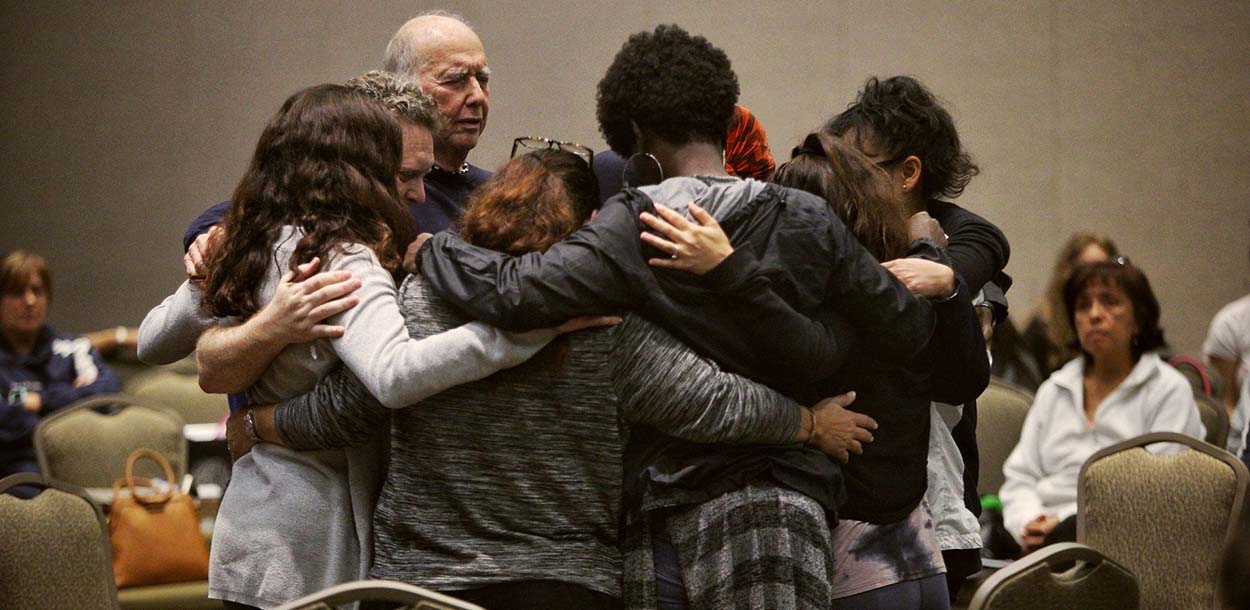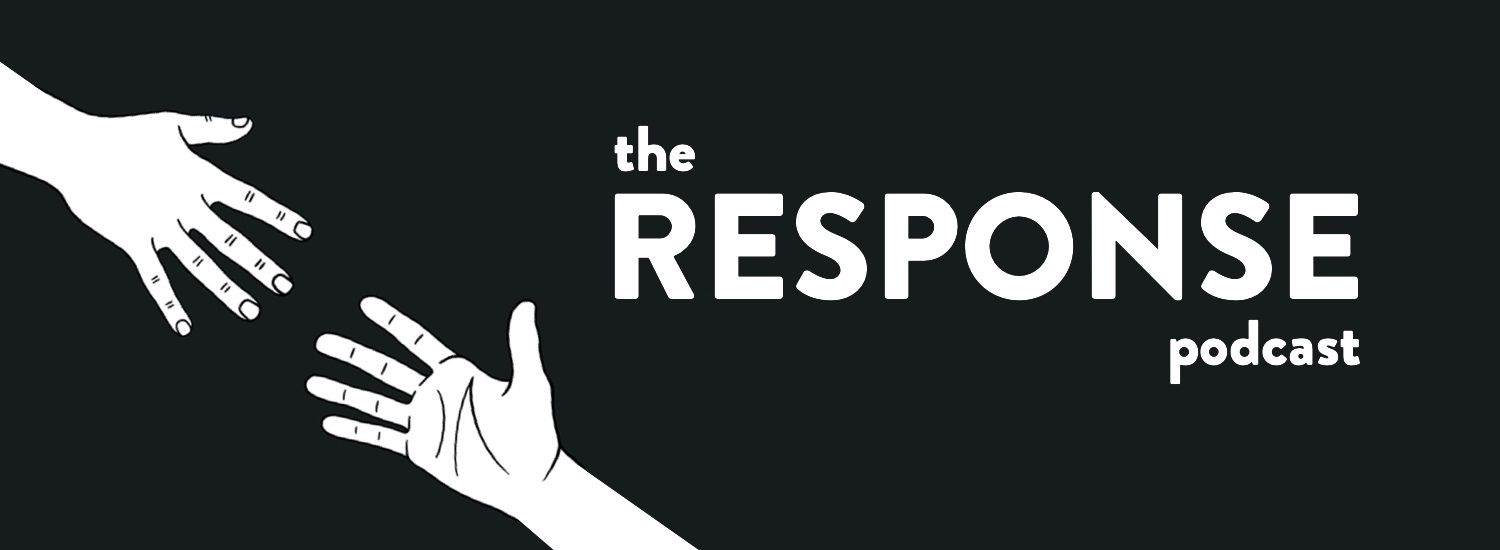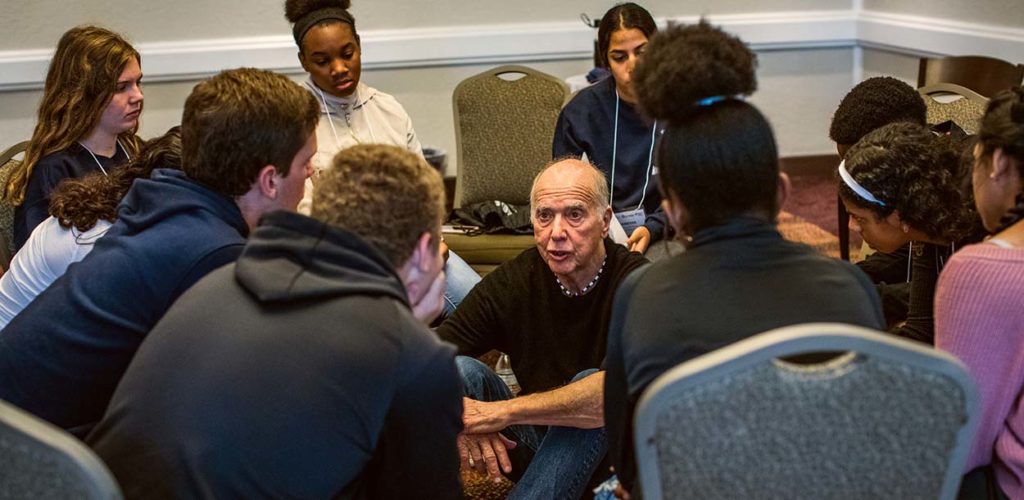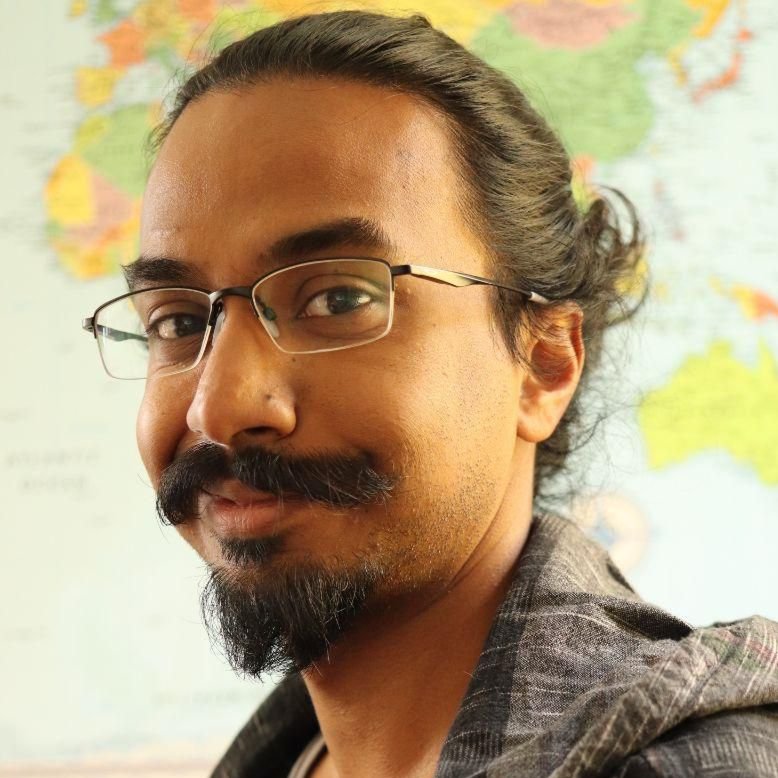As the whole country was reeling from the 2018 Valentine’s Day shooting at Marjory Stoneman Douglas High School in Parkland, Florida, members of the surrounding communities well beyond the school itself needed to find ways to heal from the violence of that day and find ways to move past the crippling trauma of that day. This is where the Center for Mind-Body Medicine (CMBM) came in with its experience in equipping populations with a set of techniques that enable healing after experiencing population-scale trauma, from South Sudan to Kosovo to Gaza and Israel.
Started in 1991 by Dr. James (Jim) Gordon, CMBM focuses on empowering people to direct their own healing from trauma using a somewhat radical approach: by equipping not just medical professionals, but parents, educators, students, and other community members and leaders with a set of techniques they can both use themselves and share with others, allowing healing to occur on a population-wide scale.
Dr. Gordon’s new book The Transformation: Discovering Wholeness and Healing After Trauma (to be released this September) is about the methods used by CMBM, as well as other ways to go about healing after trauma. We spoke with Dr. Gordon about CMBM’s community-based methods of dealing with population-wide trauma.
Listen to the full interview on The Response Podcast.
Aaron Fernando: How did you start looking at trauma and how did you start thinking about trauma differently from how it’s normally treated in Western medicine?
Dr. Jim Gordon: I started thinking about and dealing with trauma long before I knew the meaning of the word. When I was a kid… I could experience, as so many kids can, the distress that my parents were having and taking out on each other and sometimes on me.
I grew up in New York City and worked with patients in the Bronx for three years as a psychiatric resident. I didn’t see [people suffering from trauma] as pathological, although their coping mechanisms were sometimes ineffective, strange, or hard to understand. The question for me was not [about] what diagnostic category to put them in, but “how do I help them deal with the trauma?”
Why did you start the Center for Mind-Body Medicine?
I couldn’t do what I wanted to do within the conventional psychiatric medical world. I’d been a researcher at the National Institute of Mental Health where I’d spent over 11 years studying these approaches, but studying them, writing about them, helping other people with them is not the same as being in an established institution and trying to get the whole institution to function somewhat differently.
I decided what I would do is create an organization that could work with clinicians, work with educators, work with community organizers, work with people who are trying to make a difference in the world and give them the tools and the support they needed to do their work in a respectful, humane, democratic, hopeful way.
One thing that I find really interesting is that it’s not just focused on psychologists and psychiatrists, but you’re also training teachers and parents and community leaders. Is this method more effective at increasing access to dealing with stress and trauma?
When you’re dealing with population-wide trauma, there’s no alternative. I was just in South Sudan. There are 12 million people and three psychiatrists. So of course in a situation like that, we have to train leaders of women’s groups, aid workers, peer counselors, and so on.
But even here in the United States, we work[ed] in Sonoma County right after the fires they had a couple years ago. It’s the whole county that’s affected and many of the people in the county have no interest in going to see a shrink. They don’t want to take pills… they want an approach that will focus on encouraging them using their own strengths. That’s one piece. The other piece is that people want a supportive community and as we train many people within a community, it builds that support.
Do you think that’s because there’s a shared vulnerability and a breaking down of the barriers that would normally exist?
Exactly. Yes, there is that shared vulnerability and they see, “oh, she’s not so different from me. Oh, we have this in common.” We all have these ideas, preconceptions about each other, all those things that make us different — when we come together in a small group setting and you listen to other people… or you do some kind of active, expressive meditation… you realize, “my ideas about this person were 180-degrees wrong. I thought she was this, that, or the other thing and she’s really not.”
When we do the training and we have these small groups, we don’t let people argue and we don’t let people give advice to each other. They’re there to make discoveries for themselves about themselves, and we’re all there to learn from the discoveries that one of us is making.

From your work across Gaza and Israel, Kosovo, South Sudan, and everywhere else, have you seen the methods that you taught being tweaked and tailored to local conditions and cultural norms?
Things change to some degree. For example, we’re working on the Pine Ridge Reservation. That’s the Lakota people. What’s evolved is that we’ve trained them in a synthesis of mind-body medicine and traditional Lakota ceremony.
I remember I was leading a group with people from another tribe, and then something came up in the group and one of the elders was wrestling with a difficult situation. “So what do you ordinarily do?” [I asked.] She said, “we do some of the dances from the sun dance. Let’s do it now.” The work changes somewhat, but the basic principles are the same because techniques we are doing are grounded in the basis of human biology and psychology and that we’ve evolved as a species.
I found the Center for Mind-Body Medicine’s approach interesting because it seems to focus on the present rather than the past, as opposed to other methods of treatment and therapy. Is there some component of this focus on the present that leads to more favorable outcomes?
I think the antidote to trauma — this is a point I make repeatedly in my new book, The Transformation — is staying in the present. You can think of trauma as being trapped in the past and still reacting as if the trauma were continuing on a physiological level. You’re in a state of ongoing fight-or-flight, anxious, hyper-vigilant, irritable, difficulty sleeping, concentrating or you’re in a frozen state: shut down, withdrawn, replaying the events in your head, [and] having flashbacks or nightmares.
That’s the major part of trauma. The other part is [that] you’re worried about what’s going to happen next. You know, “when is the next assault going to come? When am I next going to have to deal with some other physical or emotional or social crisis, or economic crisis?” So you’re imprisoned by the past, you’re worried about the future, and you’re not in the present. So in a deep and meaningful sense, being in a relaxed moment-to-moment awareness of meditation is the antidote.
So we’re always bringing people back to that present moment. Yes, of course they can talk about the past and what’s happened and the memories that are coming up, and they can talk about their concerns about the future, but the more they learn to stay in the present, the less traumatized, the less biologically disrupted, the fewer psychological symptoms, [and] the more available they are to living their lives.
Are there any hurdles that you’re seeing to the Center for Mind-Body Medicine’s approach and specific methods being accepted in wider medical circles?
There is much greater acceptance. We’re working with the whole VA system. We’re working with the largest division of the VA in Florida, South Georgia, and the Caribbean. They have 200 whole-health coaches and many of the leadership in that division is coming through our program. So there’s much more acceptance.
But there’s still resistance. I think the resistance is, to some degree, the resistance is to self-awareness, self-care, [self-reflection] on what’s going on. It’s not only medical organizations; Many very fine aid organizations [and] human rights organizations have not taken very good care of their staff. Everybody’s trying to do what they think is the right thing to do and they [say] “well put that aside! That’s just personal stuff.” Well, it turns out not to work very well. So what we’re seeing is, increasingly — whether it’s in a hospital system or a human rights organizations or aid organizations, they’re beginning to see not only the massive trauma of people we work with and that we don’t have answers for, but also the trauma of the people who are working in that organization or that institution. So they’re beginning to embrace our approach.
For example, at Eskanazi Health, which is the largest healthcare system in Indiana, we trained, initially, 200 of their staff and their healthcare costs for their 4,500 employees were going up at five percent a year before we started — now they’re only going up at one percent a year.
It seems like you’re doing a lot of work to actually track the progress and impacts of the work you do, as well.
Research is important if you want to know if it works. Most of the research we’ve published has been on our ten- or eleven-week-long small groups on people who are diagnosed with Post-Traumatic Stress Disorder (PTSC). And those people — in studies we’ve done in Kosovo and Gaza — 80 – 90 percent of people who begin our groups with symptoms that qualify for PTSD no longer have it after 10 or 11 weeks and those gains hold for three, seven, 10 months.
One of the other things that we found with veterans is that it isn’t long enough to do a 10-week group, because the veterans — this is our hypothesis, anyway… they maintain some of the gains over time, [but] some they don’t and they need more support because many of these vets are Vietnam vets, they’ve had PTSD for 20 years, 30 years, 40 years. They need the support on an ongoing basis. The research tells us that the next time we work with vets, we’ve got to do much more. We’ve got to work with them for a longer period of time, and we’ve got to involve their family members, too. So we’re learning from the research and the research is showing that this is a very effective way of working with very diverse populations.
Finally, can you talk a little bit about the book you’re releasing in September, “The Transformation,” and what it’s all about?
The book is called “The Transformation: Discovering Wholeness and Healing After Trauma.” In many ways, it’s putting together 50 years of my work — work that started long before I started the Center for Mind-Body Medicine.
In the book, there’s a step-by-step approach to dealing with the trauma with lots of stories with people just like the people reading the book, showing how they have used these techniques — the same techniques we use and all this work we’ve done with hundreds of thousands of people with Center for Mind-Body Medicine — and how they can use [these techniques] themselves and how they can use it with their friends and families to help them heal themselves.
This kind of work helps to build community. Once you start learning these techniques for yourself and sharing them with others, you’re creating a common language that can be spoken across many differences or politics or ethnicity or age or [anything] else. You’re learning a language of self-discovery and self-care.
If you’re part of a community that’s interested in bringing our work to the community, that’s how we start. That’s how we started in East Sonoma after the fires; that’s how we started in Houston after the hurricanes; in Puerto Rico. People who knew about us said “we’d like you to come.” It required discussions and it required raising the funds to make it happen, but we’re starting because in communities are saying, “hey, we need this in our community. How can we bring it here?”
This interview has been edited for length and clarity.
##
This article is part of our series on disaster collectivism. Download our free series ebook here.










